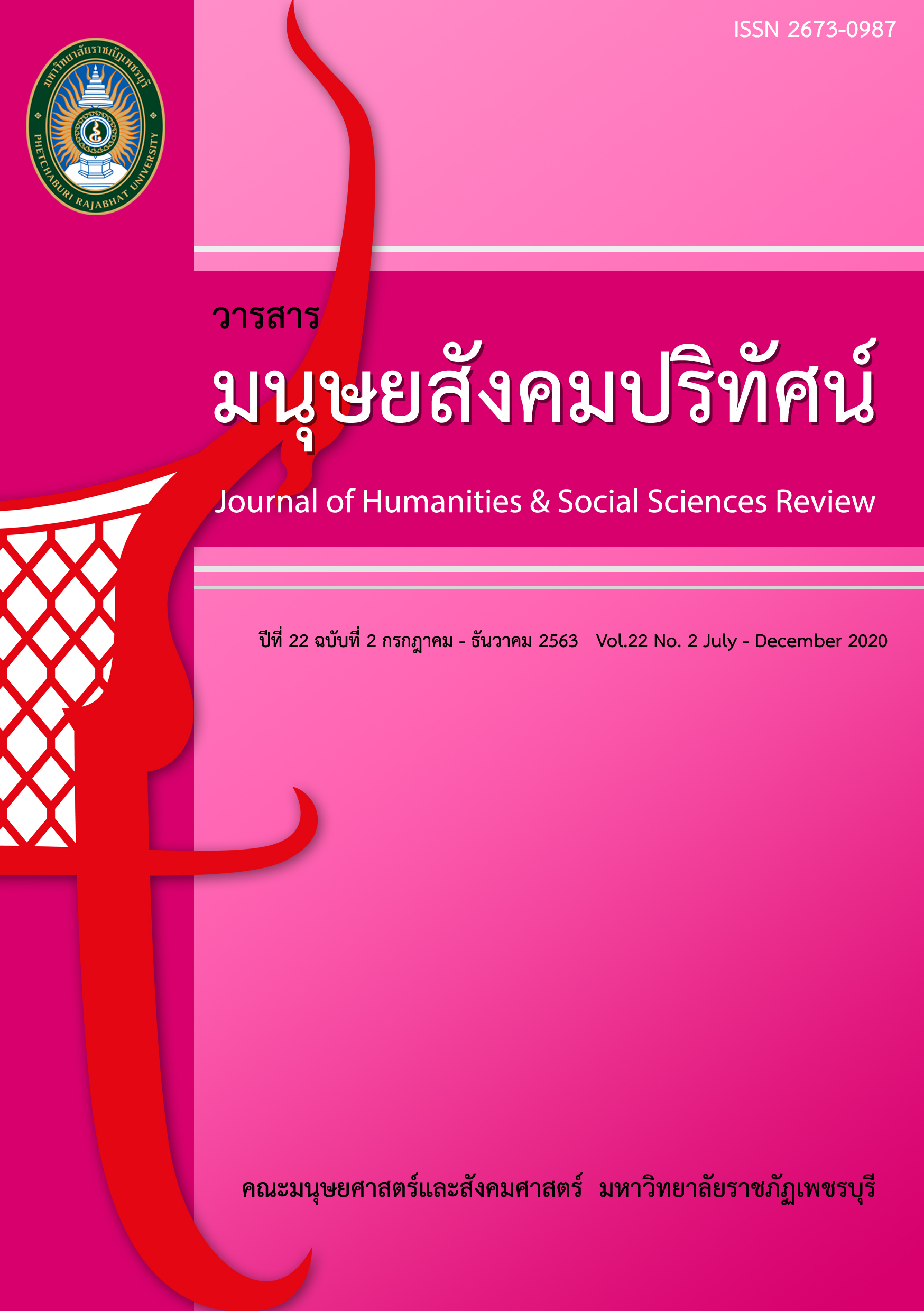องค์ประกอบและบทบาทของเพลงพื้นบ้านภาคกลางในฐานะสื่อพื้นบ้าน ในสถานการณ์ไวรัสโคโรนา
Main Article Content
บทคัดย่อ
บทความวิจัยนี้มีวัตถุประสงค์เพื่อศึกษา 1) องค์ประกอบระบบการสื่อสารของสื่อพื้นบ้านที่มีการเผยแพร่ในสถานการณ์ไวรัสโคโรนา และ 2) ศึกษาบทบาทหน้าที่ของสื่อพื้นบ้านที่มีการเผยแพร่ในสถานการณ์ไวรัสโคโรนา โดยขอบเขตการศึกษาพิจารณาจากเพจเฟซบุ๊ก สมาคมเพลงพื้นบ้านภาคกลางประเทศไทย ในช่วงที่วันที่ 20 มีนาคมถึง 20 เมษายน พ.ศ.2563 ทั้งสิ้น 19 เพลง ชนิดของเพลงพื้นบ้านภาคกลางที่พบ ได้แก่ เพลงฉ่อย ลำตัด ลิเก เพลงอีแซว เพลงรำภาข้าวสาร และเพลงขอทาน
ผลการศึกษาพบว่า 1) องค์ประกอบระบบการสื่อสารแบบพื้นบ้านซึ่งประกอบด้วยผู้ส่งสาร สาร ช่องทางการสื่อสาร และผู้รับสารนั้น ในสถานการณ์นี้ให้ความสำคัญกับสาร เป็นหลัก โดยพบข้อมูลการป้องกันตนเองจากไวรัสซึ่งพบวิธีวิธีการป้องกัน 6 วิธี ดังนี้ การสวมหน้ากากอนามัย การล้างมือด้วยสบู่ เจลแอลกอฮอล์ และสเปรย์แอลกอฮอล์ การเลี่ยงพื้นที่แออัดและเลี่ยงการพบปะสังสรรค์ การรับประทานอาหารที่ปรุงสุกใหม่ การหยุดอยู่บ้าน หรือการทำงานที่บ้านแทนการทำงานนอกบ้าน และการให้ข้อมูลเกี่ยวกับอาการป่วยหากคาดว่าได้รับเชื้อไวรัส 2) บทบาทหน้าที่ของสื่อพื้นบ้านภาคกลางมี 4 บทบาท ได้แก่ บทบาทหน้าที่ในการให้การศึกษาจากภาครัฐสู่ประชาชน บทบาทหน้าที่ในการเป็นกระบอกเสียงของผู้เกี่ยวข้อง บทบาทหน้าที่ในการบันทึกภาพทางสังคม และบทบาทหน้าที่ด้านความบันเทิง บทบาทหน้าที่ที่พบมากที่สุด คือบทบาทหน้าที่ในการให้การศึกษาจากภาครัฐสู่ประชาชน เนื่องจากต้องการให้ที่ผู้รับสารได้เข้าถึงข้อมูลหลักปฏิบัติต่าง ๆ ในสถานการณ์ไวรัสโคโรนาได้โดยทั่วกัน
Article Details
1. มุมมองและความคิดเห็นใด ๆ ในบทความเป็นมุมมองของผู้เขียน คณะบรรณาธิการไม่จำเป็นต้องเห็นด้วยกับมุมมองเหล่านั้นและไม่ถือเป็นความรับผิดชอบของคณะบรรณาธิการ ในกรณีที่มีการฟ้องร้องเกี่ยวกับการละเมิดลิขสิทธิ์ ให้ถือเป็นความรับผิดชอบของผู้เขียน แต่เพียงผู้เดียว
2. ลิขสิทธิ์บทความที่เป็นของคณะมนุษยศาสตร์และสังคมศาสตร์ มหาวิทยาลัยราชภัฏเพชรบุรีมีลิขสิทธิ์ถูกต้องตามกฎหมาย การเผยแพร่จะต้องได้รับอนุญาตโดยตรงจากผู้เขียนและมหาวิทยาลัยราชภัฏเพชรบุรีเป็นลายลักษณ์อักษร
เอกสารอ้างอิง
2. กาญจนา แก้วเทพ. (2549). ปฐมบทแห่งองค์ความรู้เรื่องสื่อพื้นบ้านสื่อสารสุข. นนทบุรี: โครงการสื่อพื้นบ้านสื่อสารสุข.
3. ณฤศดา มะลิพวง. (2559). พฤติกรรมการรับรู้และความพึงพอใจของวัยรุ่นต่อสื่อพื้นบ้านลิเกไทย จังหวัดนครราชสีมา. วิทยานิพนธ์ปริญญานิเทศศาสตรมหาบัณฑิต สาขาวิชาการจัดการสื่อสารแบบบูรณาการ มหาวิทยาลัยราชภัฏนครราชสีมา.
4. ปรานี วงษ์เทศ. (2525). พื้นบ้านพื้นเมือง. กรุงเทพฯ: เจ้าพระยา.
5. พงศ์กฤษฏิ์ พละเลิศ. (2554). บทบาทการใช้สื่อพื้นบ้านในการส่งเสริมการท่องเที่ยวของชุมชนตลาดเก้าห้อง อำเภอบางปลาม้า จังหวัดสุพรรณบุรี. กรุงเทพฯ: คณะเทคโนโลยีสื่อสารมวลชน มหาวิทยาลัยเทคโนโลยีราชมงคลพระนคร.
6. พรรณี บัญชรหัตถกิจ และจุฬาภรณ์ โสตะ. (2554). การพัฒนาสื่อพื้นบ้านเผยแพร่สุขบัญญัติแห่งชาติ 10 ประการ แนวอีสานสำหรับเด็กวัยเรียน. ขอนแก่น: ภาควิชาสุขศึกษา คณะสาธารณสุขศาสตร์ มหาวิทยาลัยขอนแก่น.
7. ยะพา เจะนิ. (2561). เพลงพื้นบ้านดิเกร์ฮูลูกับการเสริมสร้างสันติสุขในสามจังหวัดชายแดนภาคใต้. วารสารมหาวิทยาลัยราชภัฏยะลา, 13(2): 335-346.
8. วรัฐธยา สาระศาลิน และนิธิดา แสงสิงแก้ว. (2560). การวิเคราะห์บทบาทหน้าที่ของสื่อพื้นบ้าน: กรณีศึกษาประเพณีกิน ข้าวห่อของชาวกะเหรี่ยง อำเภอสวนผึ้ง จังหวัดราชบุรี. วารสารวิชาการนวัตกรรมสื่อสารสังคม, 5(1): 51-61.
9. วิไลภรณ์ จิรวัฒนเศรษฐ์. (2544). สื่อพื้นบ้านในฐานะทุนวัฒนธรรมเพื่อส่งเสริมการท่องเที่ยวที่พักทางวัฒนธรรม(โฮมสเตย์): ศึกษาเฉพาะกรณีบ้านปราสาท จังหวัดนครราชสีมา. วิทยานิพนธ์ปริญญานิเทศศาสตรมหาบัณฑิต สาขานิเทศศาสตร์ธุรกิจ มหาวิทยาลัยธุรกิจบัณฑิต.
10. ศิราพร ณ ถลาง. (2557). ทฤษฎีคติชนวิทยา : วิธีวิทยาในการวิเคราะห์ตำนาน-นิทานพื้นบ้าน. กรุงเทพฯ: สำนักพิมพ์แห่งจุฬาลงกรณ์มหาวิทยาลัย.
11. สุกัญญา สุจฉายา. (2548). พิธีกรรม ตำนาน นิทาน เพลง: บทบาทของคติชนกับสังคมไทย. กรุงเทพฯ: โครงการเผยแพร่ผลงานทางวิชาการคณะอักษรศาสตร์ จุฬาลงกรณ์มหาวิทยาลัย.
12. สำนักงานวัฒนธรรมจังหวัดปทุมธานี. (2563). ลำพาข้าวสาร ป้องกันภัยโควิด-19 COVID19. สืบค้นเมื่อ 1 กุมภาพันธ์ 2563, จาก https://www.youtube.com/watch?v=-FAtewziYg8.
13. อรพรรณ ลิ้มติ้ว. (2562). บทบาทของสื่อพื้นบ้านใน “รายการจำอวดหน้าจอ” กับการส่งเสริมวัฒนธรรมไทยของนักศึกษามหาวิทยาลัยมหิดล. นิเทศสยามปริทัศน์, 17(22): 115-122.


